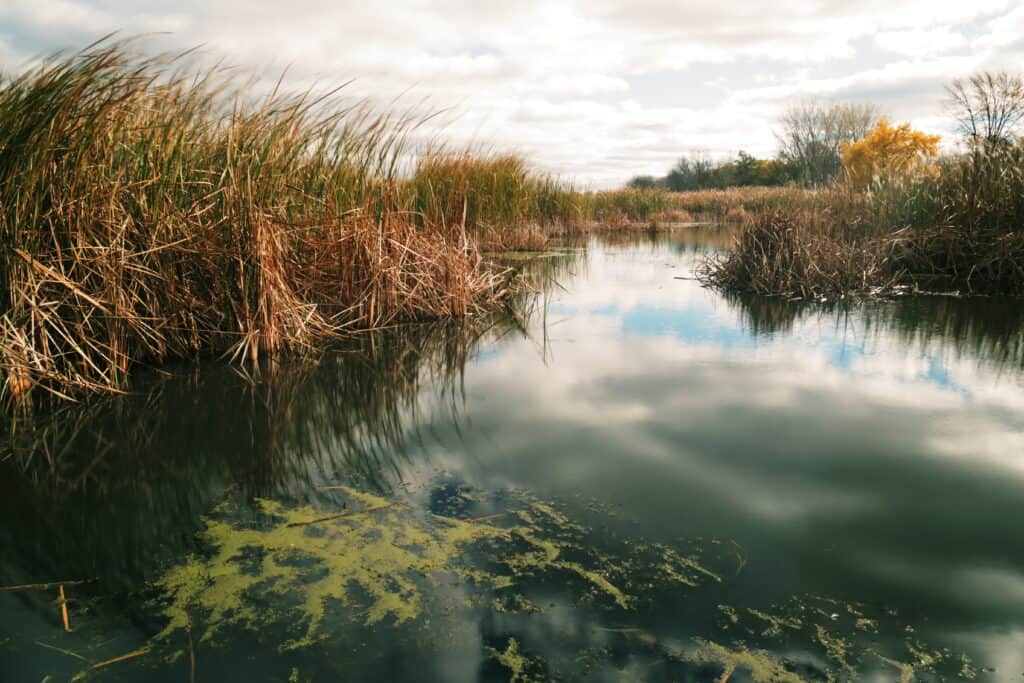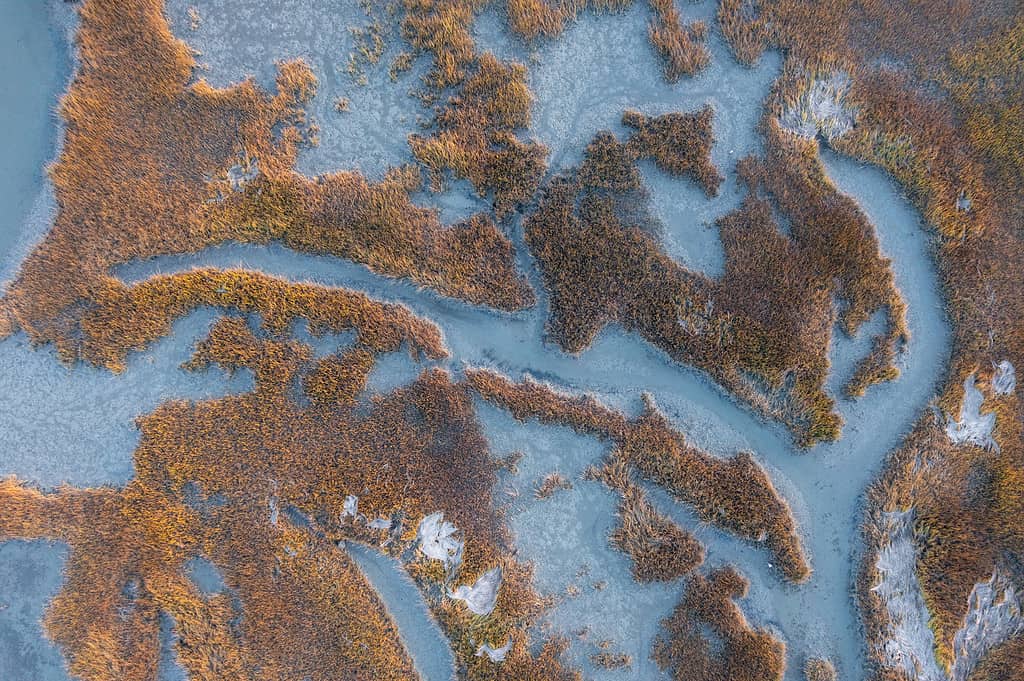
Coastal salt marshes provide wonderful habitats for all sorts of wildlife but they have other benefits as well.
©JPBC/Shutterstock.com
Coastal salt marshes have a lot to offer people, the environment, and local animals. They may not smell the best in the world, but their benefits far outweigh a little bad smell. If you want to learn more about the benefits of coastal salt marshes, where they can be found, and the animals that live here, you’ll want to keep reading.
What Are Coastal Salt Marshes?
Coastal salt marshes are a type of coastal wetland. These wetlands are flooded and drained as salt water moves in and out with the tides. They may also be called tidal marshes. Usually, what makes them a marsh instead of just a wetland is the soil underneath the water. For it to be a coastal salt marsh, the soil must be made of mud and peat.
Coastal salt marshes are a habitat most commonly found on the border between the sea and land. Because of the thick layers of peat and mud in these marshes, and the fact the area is constantly damp, they don’t always smell the best.
Decomposing plant material brought in by the tide and low oxygen levels in peat can cause hypoxia. Hypoxia is a bacterial growth that creates a smell similar to sulfur or rotten eggs. It’s quite a common smell to experience in coastal salt marshes.
Peat comes from decomposing plants. There’s a mix of herbs, grasses, and shrubs that reside in coastal marshes. They are salt-tolerant and can handle the pressure from the tides. As they die off and start to decompose, they add to the layers of peat. In some salt marshes, it’s common to find several feet of peat under the water’s surface.
Where Can You Find Coastal Saltmarshes?

Salt marshes have unique characteristics and designs.
©Kyle Little/iStock via Getty Images
You will find coastal salt marshes throughout the world. However, they are most common in the middle and higher latitudes. They are located right along the shore and may be found within or near estuaries.
In the US, salt marshes are found on every coast. Over half of all the total salt marshes near the country, however, are located in the Gulf of Mexico. The US and Australia together have over half of all the salt marshes in the world.
How Do Saltmarshes Benefit the Environment?
Coastal salt marshes are very beneficial to the environment in several different ways. One of their primary benefits is that they protect coasts from erosion. Salt marshes can do this because they buffer the power of waves. They also trap sediments.
These benefits that help to prevent erosion also are the perfect defense against hurricanes. They trap sediments and slow down waves that would otherwise beat upon the coast. Coastal salt marshes also reduce flooding because they absorb and hold onto excessive rainwater.
Another great benefit of coastal salt marshes is the fact that they filter nutrients. If there are excess nutrients in the ocean, they will slowly filter them to make it much better for the surrounding ocean.
Saltmarshes also absorb and store greenhouse gasses. because the coastal salt marshes are made from a mix of mud and peat. Both of these do a great job of absorbing surrounding carbon in the air or the water in this case. They are one of the several environments in the ocean known as ‘blue carbon’ ecosystems because they are in the ocean, rather than on land.
Some of the greenhouse gasses that they hold include carbon dioxide, methane, and nitrous oxide. They store a lot more carbon and at a faster rate than even tropical forests can store. Coastal salt marshes have the potential to store carbon 10 times faster than that of tropical forests.
How Do Coastal Saltmarshes Benefit People?

An estimated 50 percent of the salt marshes in the world have been lost in the last 100 years for various reasons.
©Tenedos/iStock via Getty Images
Coastal salt marshes help to slow erosion and the tide. Because of this, they play an important role in keeping communities safe during hurricanes and heavy rains. They reduce the number and damage from floods that are common along the coast.
According to a study done by the University of California, these salt marshes provide over $695,000 worth of value per square mile when there are storms. because of the way they reduce ocean surges and flooding. Saltmarshes along the coast even reduce property damage from areas near the flood zone by as much as 20 percent.
One acre of salt marsh alone has the potential to absorb 1.5 million gallons of water. To put it into perspective, this is over two Olympic-sized swimming pools worth of floodwater.
While human-based methods to stop destruction from floods can be used, they don’t always do the best. Sea walls are not only unattractive, but they only push the problem to someone else. Unlike salt marshes that absorb water, sea walls only deflect it. While the waves may not hit the community that has a sea wall, the water will only go to another community and cause even more harm.
Additionally, salt marshes are a key habitat for many species of fish and crustaceans that people depend on for food. Without coastal salt marshes, the food produced in the ocean would be severely limited.
Though there is still a lot to learn about these ecosystems, some preliminary research has also suggested that coastal salt marshes play a large role in our groundwater, and therefore, potentially our drinking water.
How Do Coastal Saltmarshes Benefit Animals?
Coastal salt marshes act as nurseries for many marine species. Globally, coastal salt marshes are used either for food, a nursery, or a refuge for over 75 percent of all marine animals.
Animals such as oysters and plants such as seagrass both benefit from salt marshes because they filter and keep clean the surrounding water. Both seagrass and oysters need clean water to survive. So staying around coastal salt marshes is best for their growth.
They aren’t only useful for marine animals either. Many birds also depend on coastal salt marshes. They are an easy place to eat and provide coastal birds with a lot of their meals.
Animals You Can Find in Coastal Saltmarshes

Oysters are often exposed at low tide in marshes. They will be covered up again as the tide rises.
©Amanda Cooke/iStock via Getty Images
There are so many animals you can find in coastal salt marshes. Some animals sit above the water, while others are found underneath the plants and water levels.
Some birds you should expect to find around coastal saltmarshes include the great blue heron, bald eagle, salt marsh sparrow, and osprey. You can easily find them picking around in the water, swooping over the marshes, and just hanging around.
Mice, rats, and nutria, as well as marsh deer, and raccoons also use these habitats to collect food. They may be found in the quieter hours of the morning, or at dusk when there aren’t so many people around.
As for the marine creatures you will find all sorts of crustaceans and fish such as the American eel, mosquitofish, and the fiddler crab.
Threats to Coastal Saltmarshes
One of the biggest threats to coastal salt marshes is the rising sea. As icebergs start to melt, the ocean rises a little every year. This causes water in the ocean to sit higher. Over time, the rising tides start to drown out coastal marshlands. Instead of being a place where tides provide water and then leave, coastal salt marshes are becoming permanently flooded with water.
An estimated 50 percent of the salt marshes in the world have been lost in the last 100 years for various reasons.
It’s thought that in the US alone, over 80,000 acres of coastal wetlands, which include coastal salt marshes, are lost every year. While rising tides play a large part in this, so does human growth.
Technically, as the ocean rises, most salt marshes should be able to recover. They are able to adjust and slowly creep back towards the land to match the ocean water rising. However, with human development taking up much of the space, there isn’t enough undeveloped land to allow them to move. This is why, both humans and rising tides play a huge role in the loss of coastal salt marshes.
Steps to Repair Coastal Saltmarshes
Now that people are starting to realize the importance of coastal salt marshes, people are pushing to protect them more.
One such effort is headed by a collaboration between the Florida Wildlife Federation, the US Department of Defense, and various state government agencies. The group is known as the Southeast Regional Partnership for Planning and Sustainability (SERPPAS). Their goal is to find and plan protection for a stretch of coastal salt marsh along Northeast Florida to North Carolina that makes up over one million acres of this very important habitat.
The photo featured at the top of this post is © Joanne Dale/Shutterstock.com
Thank you for reading! Have some feedback for us? Contact the AZ Animals editorial team.






